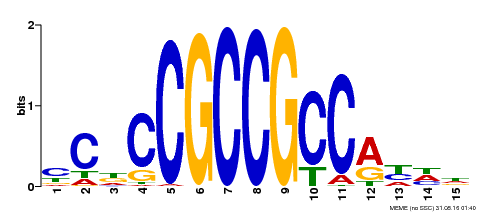 |
PlantRegMap/PlantTFDB v5.0
Plant Transcription
Factor Database
|
| Home TFext BLAST Prediction Download Help About Links PlantRegMap |
Transcription Factor Information
| Basic Information? help Back to Top | |||||||||
|---|---|---|---|---|---|---|---|---|---|
| TF ID | Eucgr.F01164.1.p | ||||||||
| Common Name | EUGRSUZ_F01164, LOC104448481 | ||||||||
| Organism | |||||||||
| Taxonomic ID | |||||||||
| Taxonomic Lineage |
cellular organisms; Eukaryota; Viridiplantae; Streptophyta; Streptophytina; Embryophyta; Tracheophyta; Euphyllophyta; Spermatophyta; Magnoliophyta; Mesangiospermae; eudicotyledons; Gunneridae; Pentapetalae; rosids; malvids; Myrtales; Myrtaceae; Myrtoideae; Eucalypteae; Eucalyptus
|
||||||||
| Family | ERF | ||||||||
| Protein Properties | Length: 232aa MW: 24459.9 Da PI: 10.2762 | ||||||||
| Description | ERF family protein | ||||||||
| Gene Model |
|
||||||||
| Signature Domain? help Back to Top | |||||||
|---|---|---|---|---|---|---|---|
| No. | Domain | Score | E-value | Start | End | HMM Start | HMM End |
| 1 | AP2 | 63.2 | 5.6e-20 | 23 | 72 | 3 | 56 |
AP2 3 ykGVrwdkkrgrWvAeIrdpsengkrkrfslgkfgtaeeAakaaiaarkklege 56
++GVr ++ +gr++AeIrdp gk++r++lg+f+taeeAa+a++ a+++++g+
Eucgr.F01164.1.p 23 FRGVRKRP-WGRYAAEIRDP---GKKTRVWLGTFDTAEEAARAYDTAAREFRGA 72
8*******.**********8...557*************************985 PP
| |||||||
| Protein Features ? help Back to Top | ||||||
|---|---|---|---|---|---|---|
| Database | Entry ID | E-value | Start | End | InterPro ID | Description |
| CDD | cd00018 | 1.00E-29 | 22 | 81 | No hit | No description |
| SMART | SM00380 | 8.1E-37 | 22 | 85 | IPR001471 | AP2/ERF domain |
| PROSITE profile | PS51032 | 24.052 | 22 | 79 | IPR001471 | AP2/ERF domain |
| Pfam | PF00847 | 1.8E-13 | 22 | 71 | IPR001471 | AP2/ERF domain |
| Gene3D | G3DSA:3.30.730.10 | 2.9E-32 | 23 | 81 | IPR001471 | AP2/ERF domain |
| SuperFamily | SSF54171 | 1.83E-22 | 23 | 81 | IPR016177 | DNA-binding domain |
| PRINTS | PR00367 | 3.5E-11 | 23 | 34 | IPR001471 | AP2/ERF domain |
| PRINTS | PR00367 | 3.5E-11 | 45 | 61 | IPR001471 | AP2/ERF domain |
| Gene Ontology ? help Back to Top | ||||||
|---|---|---|---|---|---|---|
| GO Term | GO Category | GO Description | ||||
| GO:0009723 | Biological Process | response to ethylene | ||||
| GO:0009737 | Biological Process | response to abscisic acid | ||||
| GO:0009864 | Biological Process | induced systemic resistance, jasmonic acid mediated signaling pathway | ||||
| GO:0010200 | Biological Process | response to chitin | ||||
| GO:0045892 | Biological Process | negative regulation of transcription, DNA-templated | ||||
| GO:0016604 | Cellular Component | nuclear body | ||||
| GO:0003677 | Molecular Function | DNA binding | ||||
| GO:0003700 | Molecular Function | transcription factor activity, sequence-specific DNA binding | ||||
| Sequence ? help Back to Top |
|---|
| Protein Sequence Length: 232 aa Download sequence Send to blast |
MAPREKPSVA AIPNPNGAKE IRFRGVRKRP WGRYAAEIRD PGKKTRVWLG TFDTAEEAAR 60 AYDTAAREFR GAKAKTNFPT SAELISSSRS PSQSSSLDEP SPPPPAGAVQ AAALGPPLDL 120 SLGRHPVAVA AAAGPGPYFP GAAAMCFPVM PPPPRPVFFF DAFGRMEHKK AGGAFLEACR 180 FDRPMLADFR PVIGAGVKSE PVSSASAAAE YDRPARGKSL LDLNLPPPEV A* |
| 3D Structure ? help Back to Top | ||||||
|---|---|---|---|---|---|---|
| PDB ID | Evalue | Query Start | Query End | Hit Start | Hit End | Description |
| 5wx9_A | 2e-21 | 17 | 86 | 9 | 79 | Ethylene-responsive transcription factor ERF096 |
| Search in ModeBase | ||||||
| Functional Description ? help Back to Top | ||||||
|---|---|---|---|---|---|---|
| Source | Description | |||||
| UniProt | Acts as a transcriptional repressor. Binds to the GCC-box pathogenesis-related promoter element. Involved in the regulation of gene expression by stress factors and by components of stress signal transduction pathways, and could also regulate other AtERFs. {ECO:0000269|PubMed:10715325, ECO:0000269|PubMed:11487705, ECO:0000269|PubMed:9756931}. | |||||
| Binding Motif ? help Back to Top | |||
|---|---|---|---|
| Motif ID | Method | Source | Motif file |
| MP00358 | DAP | Transfer from AT3G15210 | Download |

| |||
| Cis-element ? help Back to Top | |
|---|---|
| Source | Link |
| PlantRegMap | Eucgr.F01164.1.p |
| Regulation -- Description ? help Back to Top | ||||||
|---|---|---|---|---|---|---|
| Source | Description | |||||
| UniProt | INDUCTION: Induced by jasmonate (JA) and by Alternaria brassicicola (locally and systemically), but only slightly by ethylene. Strong induction by wounding, cold or drought stress does not require EIN2, whereas induction by NaCl does. Transcripts accumulate in cycloheximide-treated plants, a protein synthesis inhibitor. Seems to not be influenced by exogenous abscisic acid (ABA), and heat stress. {ECO:0000269|PubMed:10715325, ECO:0000269|PubMed:12805630}. | |||||
| Regulation -- PlantRegMap ? help Back to Top | ||||||
|---|---|---|---|---|---|---|
| Source | Upstream Regulator | Target Gene | ||||
| PlantRegMap | Retrieve | Retrieve | ||||
| Annotation -- Nucleotide ? help Back to Top | ||||||
|---|---|---|---|---|---|---|
| Source | Hit ID | E-value | Description | |||
| GenBank | KT031080 | 4e-54 | KT031080.1 Glycine max clone HN_CCL_133 AP2-EREBP transcription factor (Glyma06g44430.1) mRNA, partial cds. | |||
| Annotation -- Protein ? help Back to Top | |||||||
|---|---|---|---|---|---|---|---|
| Source | Hit ID | E-value | Description | ||||
| Refseq | XP_010060618.1 | 1e-162 | PREDICTED: ethylene-responsive transcription factor 4 | ||||
| Swissprot | O80340 | 2e-46 | ERF78_ARATH; Ethylene-responsive transcription factor 4 | ||||
| TrEMBL | A0A059BMS9 | 1e-161 | A0A059BMS9_EUCGR; Uncharacterized protein | ||||
| STRING | XP_010060618.1 | 1e-162 | (Eucalyptus grandis) | ||||
| Orthologous Group ? help Back to Top | |||
|---|---|---|---|
| Lineage | Orthologous Group ID | Taxa Number | Gene Number |
| Malvids | OGEM10 | 28 | 1650 |
| Best hit in Arabidopsis thaliana ? help Back to Top | ||||||
|---|---|---|---|---|---|---|
| Hit ID | E-value | Description | ||||
| AT3G15210.1 | 2e-27 | ethylene responsive element binding factor 4 | ||||
| Link Out ? help Back to Top | |
|---|---|
| Phytozome | Eucgr.F01164.1.p |
| Entrez Gene | 104448481 |



